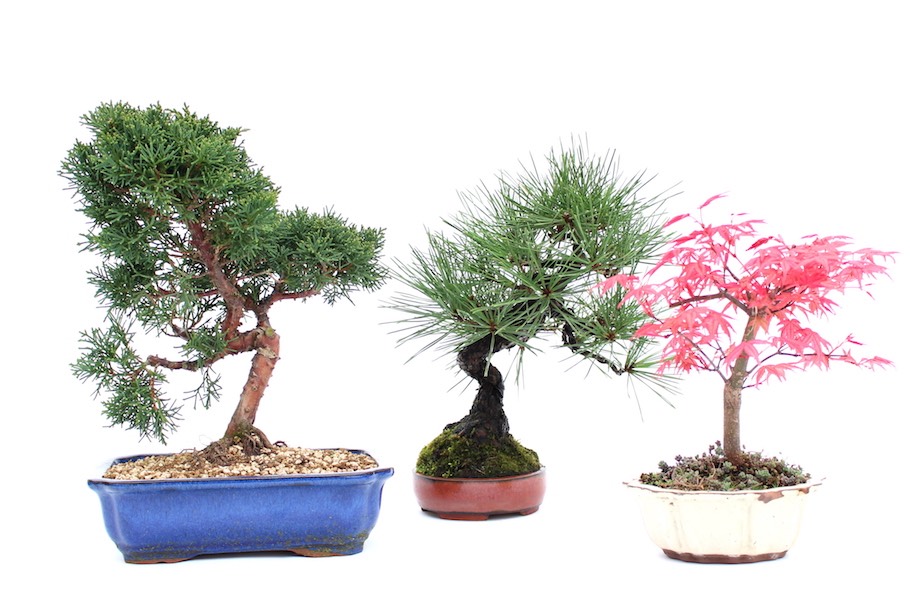Yes, bonsai trees can survive outside. They thrive best when grown in conditions similar to their natural habitat.
Bonsai trees are miniature versions of full-sized trees, meticulously pruned and shaped. These tiny trees often require outdoor conditions to flourish. They need sunlight, fresh air, and seasonal changes to thrive. Proper care involves regular watering, appropriate soil, and protection from extreme weather.
Growing bonsai outdoors helps maintain their health and vigor. It mimics their natural environment, ensuring optimal growth. Most bonsai species are hardy and can withstand various climates. Outdoor cultivation provides essential nutrients and natural elements. This practice helps bonsai trees develop strong roots and vibrant foliage. With the right care, bonsai trees can be beautiful additions to outdoor gardens.

Credit: www.reddit.com
Outdoor Bonsai Basics
Outdoor Bonsai trees can thrive in many environments. Understanding their basic needs is crucial. These miniature trees can live outdoors, but you must choose the right species and consider the climate. Let’s explore the essentials of caring for outdoor bonsai trees.
Ideal Species
Not all bonsai trees can survive outside. Here are some ideal species:
- Juniper – Hardy and adaptable to outdoor conditions.
- Maple – Beautiful foliage, suitable for temperate climates.
- Pine – Tough and resilient, great for most outdoor settings.
- Elm – Can withstand various weather conditions.
Climate Considerations
The climate plays a vital role in bonsai care. You must match the tree species to your local climate. Here is a simple table to help:
| Climate | Recommended Species |
|---|---|
| Temperate | Maple, Elm |
| Cold | Pine, Spruce |
| Warm | Juniper, Bougainvillea |
Ensure you provide the right care based on the climate:
- Watering: Water more in hot weather.
- Sunlight: Most species need full sun.
- Protection: Shield from extreme winds and frost.
Outdoor bonsai trees bring beauty and tranquility to any garden. With the right care, they can thrive for many years.
Choosing The Right Location
Selecting the right location for your outdoor bonsai tree is crucial. It affects its health and growth. The location should meet specific needs for sunlight and wind protection. Let’s dive into the details of these requirements.
Sunlight Needs
Bonsai trees generally need ample sunlight to thrive. Place your bonsai where it gets morning sun and afternoon shade. Too much sun can scorch its leaves, while too little can stunt its growth. A spot with filtered sunlight often works best.
| Type of Bonsai | Sunlight Requirement |
|---|---|
| Juniper | Full Sun |
| Ficus | Partial Shade |
Wind Protection
Wind can damage bonsai trees, especially smaller or younger ones. Place your bonsai near a wall or large plant to block strong winds. A windbreak can help, such as a fence or hedge.
- Use natural barriers like bushes or trees.
- Avoid placing bonsai in open, windy areas.
- Consider using a protective cover during storms.
Follow these guidelines to ensure your bonsai tree thrives outside. Proper location is the first step to a healthy, beautiful bonsai.
Seasonal Care
Seasonal Care is crucial for ensuring your bonsai tree thrives outdoors. Different seasons require different care routines. Adjusting your care regimen according to the season ensures the health and longevity of your bonsai.
Spring And Summer
During spring and summer, bonsai trees enter their growth phase. This period demands more attention and care.
- Watering: Water the tree regularly. The soil should stay moist, not soggy.
- Sunlight: Ensure the tree gets 6-8 hours of sunlight daily.
- Fertilization: Feed the tree with a balanced fertilizer every two weeks.
Spring is the best time for repotting and pruning. Inspect the roots and trim if necessary. Use sharp tools to avoid damaging the tree.
Fall And Winter
Fall and winter bring dormancy to most bonsai trees. The care routine changes to protect the tree from harsh weather.
- Watering: Reduce watering frequency. Soil should be slightly dry between waterings.
- Sunlight: Place the tree in a location with indirect sunlight.
- Fertilization: Stop fertilizing in late fall to prepare for dormancy.
During winter, protect the bonsai from frost. Use mulch to insulate the roots. Move the tree to a sheltered area if temperatures drop significantly.
Understanding seasonal care ensures your bonsai tree remains healthy year-round. Adjusting care routines according to the season supports optimal growth and resilience.
Watering Practices
Caring for a bonsai tree outdoors requires special attention to watering practices. Proper watering ensures your bonsai stays healthy and thrives. Let’s dive into some key aspects of watering practices, focusing on frequency and water quality.
Frequency
Bonsai trees need regular watering to stay healthy. The frequency depends on the tree species and the climate. Typically, outdoor bonsai should be watered once a day during warm weather. In cooler weather, every two to three days is usually sufficient.
Use your finger to check the soil’s moisture level. If the top inch of soil is dry, it’s time to water. Over-watering can lead to root rot, so avoid watering if the soil is still damp.
Consider these tips for watering frequency:
- Water in the morning to allow the soil to dry before night.
- Increase watering frequency during hot, dry weather.
- Reduce watering during rainy periods.
Water Quality
The quality of water you use is crucial for your bonsai tree. Tap water can contain chemicals that harm the tree. Whenever possible, use rainwater or distilled water.
Hard water with high mineral content can cause salt buildup in the soil. If you must use tap water, let it sit for 24 hours to allow chlorine to evaporate.
Here are some tips on ensuring good water quality:
- Collect rainwater in a clean container.
- Use a water filter to remove impurities.
- Test the pH level of your water; aim for a neutral pH.
Maintaining optimal water quality helps your bonsai tree absorb nutrients more effectively.
| Water Source | Quality Level |
|---|---|
| Rainwater | High |
| Distilled Water | High |
| Filtered Tap Water | Medium |
| Unfiltered Tap Water | Low |
By following these watering practices, your outdoor bonsai tree will grow healthy and strong.
Soil And Fertilization
Understanding the right soil and fertilization is crucial for the health of your outdoor bonsai tree. The correct soil mix and proper nutrient requirements will ensure your bonsai thrives. Let’s dive into the details.
Soil Mix
Your bonsai tree needs a special soil mix to grow well outside. The soil should provide good drainage and aeration. Here is a simple mix:
| Component | Percentage |
|---|---|
| Akadama | 50% |
| Pumice | 25% |
| Lavastone | 25% |
This mix helps in retaining water and nutrients while allowing excess water to drain away.
Nutrient Requirements
Bonsai trees need specific nutrients to grow healthy. Fertilizing your bonsai is important. Here are the key nutrients:
- Nitrogen (N): Promotes healthy leaf and stem growth.
- Phosphorus (P): Aids in root development and flower growth.
- Potassium (K): Supports overall health and disease resistance.
Use a balanced fertilizer with these nutrients. Apply it every two weeks during the growing season. Avoid fertilizing during winter as the tree is dormant.
Ensure you follow these soil and fertilization guidelines. This will help your outdoor bonsai tree thrive.

Credit: www.amazon.com
Pruning And Shaping
Pruning and shaping are essential for the growth of a healthy bonsai tree. These techniques help maintain the tree’s miniature size and aesthetic appeal. Proper pruning and shaping also ensure better air circulation and sunlight penetration.
Pruning Techniques
Pruning involves the removal of certain parts of the tree. This can include branches, buds, or roots. The goal is to enhance the tree’s shape and health. Always use sharp, clean tools for pruning. This prevents damage and infection.
Here are some common pruning techniques:
- Pinching: Use your fingers to remove new growth.
- Leaf Pruning: Cut off large leaves to encourage smaller ones.
- Structural Pruning: Remove larger branches to shape the tree.
Wiring Tips
Wiring helps in shaping the bonsai tree by guiding the growth direction of branches. Use wire to wrap around branches and gently bend them into the desired shape. Choose the correct wire thickness to avoid damaging the tree.
Here are some tips for wiring:
- Choose the Right Wire: Use aluminum or copper wire. Aluminum is easier for beginners.
- Wrap Carefully: Wrap the wire at a 45-degree angle.
- Check Regularly: Inspect the wire often to ensure it’s not cutting into the bark.
By following these pruning and wiring tips, your bonsai tree can thrive outdoors. Regular care will keep your bonsai looking beautiful and healthy.
Pest And Disease Management
Managing pests and diseases is crucial for the health of your outdoor bonsai tree. Proper care will ensure your bonsai thrives and remains beautiful. Let’s explore common pests and ways to prevent diseases.
Common Pests
Outdoor bonsai trees can attract various pests. Here are some common ones:
- Aphids: Small insects that suck sap from leaves. They can cause wilting.
- Spider Mites: Tiny pests that create webs and damage leaves.
- Scale Insects: Hard-shelled insects that stick to branches and leaves.
- Caterpillars: Larvae that chew on leaves and stems.
To manage these pests, you can use natural predators, insecticidal soap, or neem oil. Regularly inspecting your bonsai tree is also key.
Disease Prevention
Diseases can harm your bonsai tree’s health and appearance. Here are some ways to prevent them:
- Watering: Water your bonsai properly. Avoid overwatering to prevent root rot.
- Air Circulation: Ensure good air flow around your bonsai. This reduces fungal growth.
- Sanitation: Keep the area around your bonsai clean. Remove fallen leaves and debris.
- Soil Care: Use well-draining soil. Replace it periodically to prevent soil-borne diseases.
By following these steps, you can keep your outdoor bonsai tree healthy and vibrant. Regular care and attention are key to pest and disease management.

Credit: www.bonsaiempire.com
Winter Protection
Can bonsai trees survive outside during winter? Yes, with proper care. Protecting them from harsh winter conditions is crucial. Here’s how to keep them safe and healthy.
Frost Prevention
Frost can be deadly for bonsai trees. Frost prevention is key. Here are some tips:
- Move your bonsai to a sheltered location.
- Use a frost cloth to cover the tree.
- Place mulch around the base for insulation.
These steps help keep the roots warm. Cold roots can damage the tree. Always check for frost warnings.
Overwintering Tips
Overwintering your bonsai correctly ensures its survival. Follow these tips:
- Water the tree sparingly. Excess water can freeze.
- Provide indirect sunlight. Direct sun can be too harsh.
- Monitor the tree for pests. Winter pests can harm the tree.
Keep an eye on the weather. Adjust protection measures as needed. Your bonsai will thank you with healthy growth in spring.
Conclusion
Bonsai trees can thrive outdoors with proper care. Ensure they receive adequate sunlight, water, and protection from extreme weather. Choose species suited for your climate to enhance their survival chances. With attention to their needs, your outdoor bonsai can flourish beautifully and become a stunning addition to your garden.
